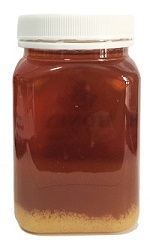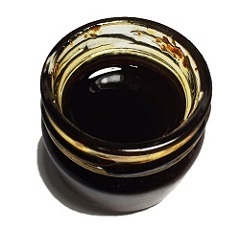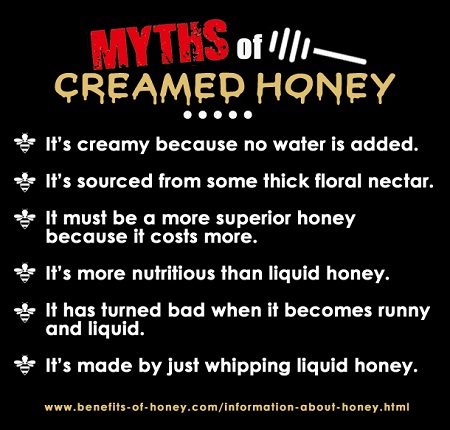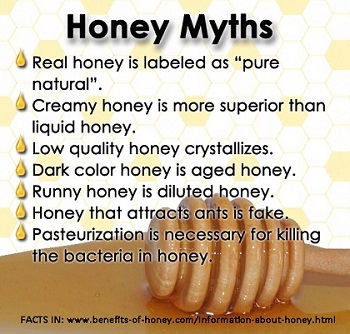
17 Honey FAQs [Frequently Asked Information About Honey]
Below is some very valuable information about honey which many of you have frequently queried through our website.
1. My honey has turned coarse, grainy and looks sugary and unappetising. Is it a sign of adulteration with processed sugar or has it gone off?
Granulation or crystallisation of honey is a natural process and does not affect the quality of honey. You can still eat it.

Some floral varietals have a tendency to granulate more quickly than others and cold temperature also speeds up the rate of crystallisation (especially below 10 degrees Celsius). In warmer climates (where temperature reaches 30 degree Celsius or higher), honey remains runny much longer. To return grainy honey to its clear liquid state, simply place the jar over a warm water bath (40-50 degree C.)
Interestingly, I have met a few people who actually prefer crystallized honey to liquid runny honey as they feel it is easier to handle crystallized honey (just like creamed honey) in cooking and baking. And being drip-free, crystallized honey works well as a spread for bread and glaze for meats and fish. Someone has even told me that crystallized honey simply tastes better as he enjoys biting into the grains of the sugar crystals!

2. Why does my creamed honey darken and become runny?
Over time, warm climate or environment can cause cream honey to become darker in colour and less viscous and runnier. The honey has returned closer to its original liquid state. For creamed honey that is too solid hard, you can run the jar in a warm bath to make it runny again.. Nevertheless, avoid placing honey near the windows and on shelves above the kitchen stove as high temperature can cause honey to lose its flavour. As a general principle, warm to soften, cool to firm.
Many people erroneously associate dark honey with "aged honey" and an attribute of superiority gained over time. Actually, "aged honey", which is generally more intense in flavor, refers to honey resulting from aging and fermentation of the honey in the natural wild bee hive. This it is thus different from the honey that has been extracted and stored in containers for a long time.
3. Are all honey that is not labelled "raw honey" pasteurised?
Honey that is not labelled raw may not necessarily be pasteurised (heated to about 60-70 degrees Celsius). Honey offered by some quality honey suppliers only lightly warm their honey (about 40 degrees Celsius) for the purpose of easier straining and bottling, whereby all the nutrients and live enzymes are still kept in. There is no clear regulation on the definition of "raw" on the label. Honey that is cold filtered directly from the extracting barn is often differentiated by the "raw honey" label. However, honey that is lightly warmed may not be labelled as "raw" even though it has not undergone any pasteurisation process. Also, if you get your honey direct from the farmers' market or direct from the beekepers, chances are that their honey does not come with fancy packaging covered with marketing claims and is not labelled "raw" but is in fact totally unheated and unpasteurised. The message here is, if you are particular about eating raw honey, the "raw" label is not a 100% guarantee, because the most errant and unethical honey supplier is capable of offering highly processed honey with the label "raw".
4. Is honey labelled as "pure natural honey" real honey?
Pure natural honey is expected to be undiluted and have no additives, preservatives, artificial or synthetic ingredients. It contains only one ingredient - honey. Unfortunately, this is not always the definition for commercial honey. There is no standard commercial requirements for the use of the words "pure", "natural", "raw" in marketing, disclosing the ingredients in details and labelling honey.
Frequent reports of fake honey tell us that in many places, it is not difficult to find bottles labelled as "pure honey" when they contain only a small percentage of pure honey. It's best to get your honey direct from a trusted beekeeper, otherwise, make sure that the honey brand you pick up is a reliable, trustworthy and ethical one committed to offering truly 100% pure real honey.
5. What is raw honey and is all raw honey creamed?
Raw honey is basically totally unheated, unprocessed. Because some floral varietals of honey tend to granulate and appear sugary over time, some honey companies process/heat and stabilize their honey to stop crystallization and keep their honey in clear, desirable form on the shelves. Creaming (ie processing under low temperature without harming the live enzymes of honey) is another method used by honey suppliers to slow down cystallisation of honey. But there are exceptions of course; some floral varietals granulate very slowly (ie they stay clear and uncrystallized for years), so raw honey can too be found in clear liquid form. And most of the time, when you get unlabelled bottles of honey direct from small-scale beekeepers, it is in the raw liquid form.

6. Is creamed honey more superior to clear liquid honey?
For those who have purchased cream honey as the only form of honey before, they tend to become suspicious of the quality when they encounter liquid honey for the first time and question if there is anything wrong with the quality, and on the contrary, for those who come across creamed honey for the first time, they wonder if it is something more superior than the liquid honey which they have been taking. Many marketing labels such as "nothing is added, that's why our honey is so creamy" are adding to the confusing and misleading consumers into thinking that the creamier the honey, the more superior it is. (More on these erroneous labels in Eating Real Honey?)
The truth is, the creamy texture of honey does not imply any superiority in terms of quality or health benefits. Creamed honey is formed by blending a specific ratio of finely granulated honey and liquid honey. The mixture is then placed in cool storage to promote rapid granulation and produce a small crystal structure that results in a smooth creamy texture. The precisely controlled crystallisation process also lightens the color of honey (some creamed honey is white), but does not alter the taste or affect the nutritional value. The only difference in cream and clear liquid honey is the form and texture, nothing more and nothing less.
7. Why do some commercial brands pasteurise their honey?
Many people assume pasteurisation kills bacteria in honey and hence is a commercial requirement for honey to be sold in the stores. But this is not true. Pasteurisation is actually very much a marketing issue. Certain varietals of honey crystallise quickly and are seen as defects by consumers. Pasteurisation retards the crystallisation process and keeps the honey presentable on the shelves. In some countries, I get puzzled looks when I ask if the honey is raw or pasteurised. Obviously they find my question very strange because there is absolutely no need to pasteurise honey!
8. Why is the floral type (e.g. Macadamia, Manuka, Eucalyptus, Aster, Dandelion, etc) indicated for only some honeys?
Honey that does not indicate its nectar source is also called floral blend, bush honey, or multifloral honey. Sometimes generic names are also given - wildflower honey, desert honey, mountain honey, Himalayan honey, winter honey, summer honey, Yemen honey, etc. The bees can forage a number of different flowers but the precise floral origin of the honey is not identified. Monofloral honey varietals are nectar collected by the bees that forage from one single or predominant source, resulting in a honey with its own unique flavor and aroma. Identifying and separating honey into distinct floral varietals can be a costly affair.

9. Is Manuka honey better than other floral varietals?
Hydrogen peroxide antibacterial property is common to most honey, but New Zealand's Manuka honey with an Active rating of 10+ and above contains an additional special antibacterial strength (Non Peroxide Activity) that helps to differentiate it as a medicinal honey from the rest of food-grade honey. (Note: Manuka honey with an NPA or UMF rating lower than 10+ is as good as regular/food grade honey.)
Manuka honey is perhaps the world's most thoroughly studied and marketed honey varietal, hence its medicinal benefits are well-known. There are likely to be many medicinal grade honey varieties out there, in different parts of this world, but only enough commercial interest and research would lead to the discovery of these. Whether we like it or not, the truth is, the popularity of a product, including honey, is driven to a mammoth extent by the media. More on this topic in: UMF Manuka Honey And Its Big Price Tag and Manuka UMF and Other Activity Terms Explained.
10. What other attributes (other than brands) could influence the price of honey?
Apart from brands (which can have a significant impact on honey quality due to differences in nectar sources, beekeeping practices and beliefs and honey handling), other factors include whether honey is "certified raw", whether honey is "certified organic", whether it is a monofloral varietal, the abundance of the supply of that floral varietal, and whether it is a medicinal grade or food grade honey. Thus, there isn't a straightforward explanation to why for instance it is possible for two bottles of Manuka honey Active 10+ to have a marked difference in price.
11. What is "local honey" and where can I get it?
Local honey, which is known to be highly beneficial in treating seasonal allergies, comes from the bees that live in your neighbourhood. There isn't a fixed definition to local honey in terms of mileage, but it usually means 5 mile and up to even 100 mile radius from where you live; the nearer it is, the better. As there is no honey production activity in Singapore, the so-called "local honey" does not exist here. So, if you reside in Singapore or you have just relocated here and someone sells you "local honey", you know what to do.
12. I have only eaten regular honey from the supermarket before and am hesitant to try raw honey. I'm not sure if I would like the taste of raw honey.
Taste should not be a concern. You can't tell whether a honey is raw or has been heated by tasting it. Having the quality of "raw" doesn't give honey a distinguishable "raw" taste. But because raw honey is loaded with all the live enzymes, it does somehow feel good to eat raw honey!
13. Is thick, viscous honey better than runny honey?
Most people don't understand what makes honey thick or runny. Some assume thick honey is raw and thin, and watery water has been heated. This is not true. Raw honey is not always thicker than processed honey. Hot honey will be more runny but will eventually return to its original viscosity when cooled. So, viscosity is not a sure way to judge whether your honey is raw or has been pasteurized. "Raw" does not equate with "thick" for honey.
Viscosity of honey varies depending on the nectar source. Honey is a reflection of the place (weather, humidity, rainfall, soil, landscape) and the flora the bees forage (nectar viscosity varies depending on flower types). Some floral varietals of honey from certain countries are naturally more viscous than others. For instance, honey from China and Taiwan tends to be runnier. Another reason for watery honey is harvesting the honey too early when the honeycomb is still unripe and uncapped. The bees bees flap their wings to encourage water evaporation until the honey becomes concentrated, and then they cap the honeycomb with wax. If honey is harvested before enough water is evaporated, the moisture content will be too high. Hence, runny honey is not always a sign of adulteration or production from sugar-fed bees, thus viscosity should not be taken as a deciding factor of honey purity or quality. Many of our visitors from the United States and Europe consider runny honey from Asia as "garbage". While the reputation of China honey indeed has been horrendous, a bottle of China honey when found to be runny does not necessarily mean for sure that it is totally worthless or it has been mixed with sugar water.
14. How should honey be stored?
Honey is best kept in air-tight jars (made of glass or quality food-grade plastic) in a cool place, away from the sun or direct light. Cold weather and refrigerating can cause honey to become granulated and hard, and hot weather can also cause it to lose flavour and become darker in colour over time. However, for very runny honey with high moisture content, e.g. Asian stingless bee honey, refrigeration is recommended to prevent fermentation and souring of honey. More information about honey storage in: Honey Storage Tips.
15. Is the whole piece of honeycomb edible?
Yes, the whole honeycomb can be eaten and swallowed. The wax is made by the bees from the nectar. Many found the natural wax to be an excellent roughage, however most people still prefer to chew it like a gum and spit out the remaining hard wax.
16. Is the ant test a good test for honey purity?
The ant test for honey purity is a myth. Ants generally are attracted to sweet foods, and different species of ants (in different places) are attracted to different types of honey (ie depending on the floral varieties) in varying degree. Hence whether ants would be attracted depends on various factors including place (try changing storage place), ant species, honey varietal. (In fact, many beekeepers said ants loved their genuine honey!) To keep ants away, wipe the lid of the bottle clean and dry after each use as any drip may attract ants.
17. Can I use a metal spoon to scoop honey?
There are people (not many though it seems) who believe that the acids in honey can decompose copper and iron and produce toxic salts and so generally metal spoons should not be used to avoid the change of honey taste or transfer of undesirable metallic substances. However, this is surprising because most beekeepers' equipment is known to be made of stainless steel, thus it very unlikely that the brief contact between the honey and stainless steel spoon would be of too big an issue and so far there is no scientific data to substantiate this concern. Using wooden spoons is more of a lifestyle than a health reason (as many would tell you that it feels good to hold a cutlery made of wood in your hand). Hence, one shouldn't be unduly worried if they are scooping honey with a spoon made of stainless steel, porcelain, stainless steel, glass, ceramic or even food-grade plastic.
"Not all honey is created equal."
Related Articles
1. Discover how much you know about honey with this quick quiz. Your quiz results might well surprise you! All in: Do you really know me, honey?
2. Is every kind of honey good, so long as it is real honey? More in: Any Honey is Good?
3. Honey comes in various forms - comb, liquid, creamed, etc. Learn more in: Forms of Honey.
4. Some consumers assume cream or whipped honey is the most superior form of honey. Is it true? Find out in: Sticky Facts about Cream Honey
5. What is the best way to store honey? Find out in: Honey Storage Tips.
6. My honey has become coarse and grainy. Is it still edible? Your answer in: Crystallization of Honey.
7. Be a smart consumer. Know how to read honey labels: Natural Honey, Pure Honey, Raw Honey ~ Making Sense of Honey Labels
8. Which Honey to Buy?: Raw, organic, multifloral, monofloral, local, imported and commercial Honey?
9. What Erika Cornish, a beekeeper from Canada, has to say about honey that crystallizes in the fridge: The Beekeeper and Good Honey.
Note: Please give some time for your post to appear as there is a monitoring of posts to weed spams out of the system. Only posts relevant to the topic will be published. Thank you!
Postings on Honey FAQs
Hi, I would like to give you some information my family discovered about honey ourselves in terms of metal.
Any kind of plated metal should not be used. My grandfather decided to pour honey into zinc buckets he had that were food grade and that he used to use for boiling crabs as a professional fisherman.
It was only left overnight and poured into plastic containers for sale 10 hours later we could actually smell the zinc and when we tested the honey it was aweful... the entire batch of honey was ruined it tasted like zinc.
Mixing any acidic containing foods with plated metal containers turns out to be a bad idea due to it causing reverse electroplating.
Also leaching of chromium into acidic foods has also been shown to be a health risk for any acidic food(3 mins of boiling tomato soup in stainless pot reaches toxic levels), so while using stainless containers short term such as the decapping knife/extractor contact time should be limited with honey and not stored in stainless containers.